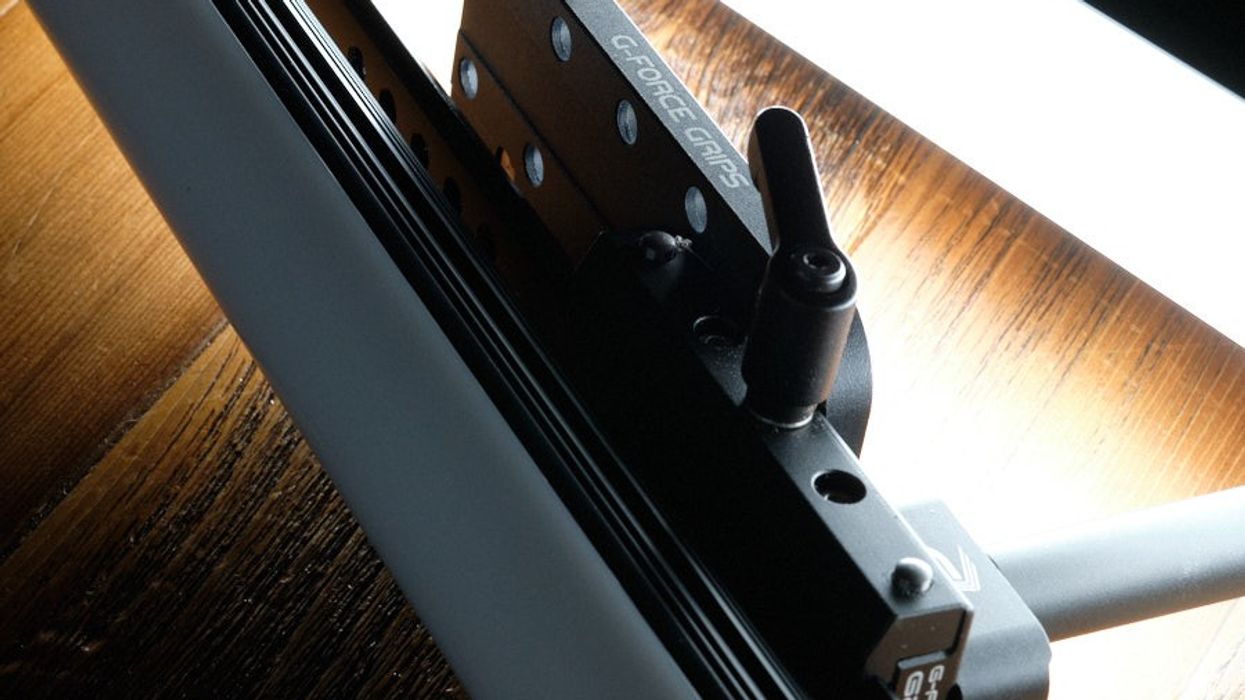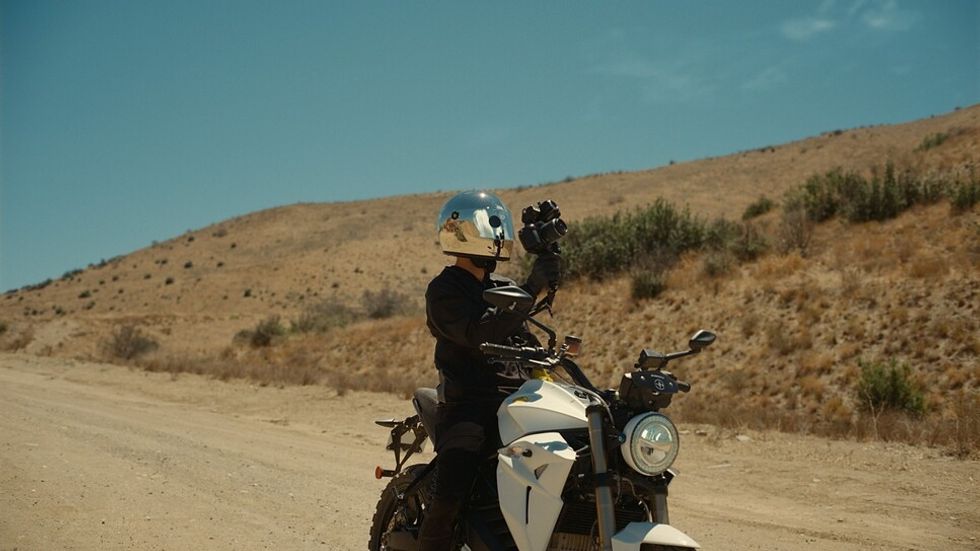Quasar's Double Rainbow Is an LED Tube with Punch
The leader of tube LED lights revises its units for more punch and more flexibility.

LED tube lights have fast become an essential part of most filmmakers' toolkits. The ability to have a soft source that you can easily mount in a variety of settings, and that outputs all the colors under the sun, offers filmmakers so much flexibility that they show up in all sorts of unexpected places. Not only are they great for tight interior work in cars or small rooms, but they can also be useful on larger and more complicated setups where their ease of use makes them a fast rig when you need just a touch of light.
Quasar Science is among the undisputed leaders of LED tube lighting with its Rainbow units, and they are now back with two major revisions, the Double Rainbow (a double-wide rainbow tube) and the Rainbow 2, which is the original width but offers a whole host of revised tools.
We got to use them for a few weeks and walked away impressed. While they have a lot of toolsets in common, so we'll discuss them mostly together, we'll discuss differences down at the bottom as well.
Output
There are two main headline features with these lights, output and color accuracy.
Let's deal with output first; these units are bright. Like "useful in a new kind of way" bright. Especially the Double Rainbow had me thinking about tube lights for things I would never have done with a tube light before.
For instance, in a recent interview, the subject had a big, beautiful massive light wall that illuminated their space. It was gorgeous, filling their studio with light and creating an airy atmosphere. When setting up for the interview, I decided to see if the Double Rainbow could handle the need for fill, to create a nice punch and shape on the subjects without leaving us out of luck and letting us work more quickly.
With the Rainbow, we didn't need to set up a stand and run modifiers. The 2' double rainbow was bright enough we dimmed it down, even as a key light fighting against sunny windows.
Filling in for sunlight from a tube light is just totally awesome. Normally a 2x1 would be the tool for the job, but you don't want to plop a 2x1 on someone's coffee table.
With the tube light, we kept a small footprint, no stands, in a full architecture studio and still got a better lit final result.
The 2' R2 in "high output" mode at D6500 gives you an F8 at 1 foot and an F2.8 at 6 feet.
The Double Rainbow 2' gives you a bonkers F11/16 split at 1 foot and an F4 at 6 feet when shooting at ISO800.
This is just a ton of light output for a tube light. Even the R2 is plenty of output for a 2' unit where you can stick it in a car, above a vanity, or carry it handheld. But that Double Rainbow just absolutely kills at output. Getting really close to F16 at 1 foot, and giving F4 at 6 feet, is amazing.
If you are working on a night exterior, for instance, you're still going to see something like an F2 up there around 20 feet, which gives you a ton of room to work with the unit.
RGBWW/Color Accuracy
The other area where these units really shine is color accuracy, which makes sense considering this is what Quasar is best known for.
A lot of tube lights are just pure RGB, and they use the combination of those RGB LEDs to give white output that is actually very segmented and not coherent. That isn't the case with the Rainbow 2 and Double Rainbow. They have dedicated daylight and tungsten LED units built in that give broad-spectrum color response. This allows for better color reproduction.
The way the unit is designed is also particularly smart in that, when working in RGB mode, if you turn the saturation down to zero, the WW units come into play as well, leaving you a brighter unit than you can get with full saturation. You still end up with accurate color and high CRI and color reproduction from having those proper LEDs in the mix.
Pixel Volume
One of the sneaky features that is really appreciated about the new Double Rainbow units is the sheer volume of individual pixels that are built into the unit.
A pixel is a group of LED bulbs that can be programmed separately for lighting effects.
Think about a fire effect; for that pre-programmed effect to work, you need the light to be different colors in different places. One end should be brighter and oranger than the other, and they should all cycle through settings chaotically to really feel like fire.
For this, and countless other effects, the more pixels the better. More pixels mean smaller groups of LEDs working together to create light effects. So, if you create that glowing firelight, it won't look like one giant bulb working together, but instead will have a wide variety of individual-looking units all over the light working as a team to create the wrapping effect. With the 2' bulb you end up with 10 separate pixels.
Of course, you don't always have to use all the pixels. When working with something like DMX, every pixel will take up more DMX channels (and more than a single channel, since you'll need a channel for intensity, one for hue, and one for saturation), so you can choose how many pixels to set up when working DMX for the variety of setups you might need.
Control
This is an area of competition in LED lighting lately. Output is a big one. Color accuracy is another. But one that doesn't get enough attention is light control options.
In continuing with the theme of this article, Quasar has really put in the work with the Rainbow 2 and the Double Rainbow to ensure that they are capable of being controlled in an absolutely bonkers number of ways.

Quasar doesn't have its own app, which might come as a surprise. Each company generally feels compelled to have its own app, but it's honestly not ideal to put that pressure on smaller light manufacturers. If you are a hardware maker building a team to create an app, keep it updated, keep it working on a variety of ever-evolving platforms, that is work that is outside your key skillset, which is hardware.
On top of that, most of us don't want to pay separately for the app but expect it to come free with the light. Quasar instead has focused on connectivity with traditional DMX workflows and made those as flexible as possible, while also giving you on-unit control if you need it. A focus on lighting integration is a smarter move, and we respect it.
The units work as both ethernet nodes and ethernet switches when working with DMX over ethernet to the two ethernet ports built right into the unit. This makes your wiring more flexible when you are designing your layouts for longer-term installs, and should be appreciated by those working with DMX infrastructure. If you aren't going to be running an ethernet cable, the unit also has built-in wifi and Bluetooth capability without needing to install an adapter.
It's also important to point out there are on-unit controls.
Almost every tube light has these, but there is one light that doesn't, so it's a good thing to remember that this one does have a menu and enough buttons to pretty quickly make the changes you need to make. There are also some little tricks to make it faster, like holding down "+" and "-" together can take you to min or max immediately, so it's always worth reading the manual to remember the fastest way to do things.
Mounting
Quasar uses the Ossium mounting rail system to make it flexible to mount your light. These are robust metal rails built into the unit, with a little spring-mounted stop at the end to prevent accidental slippage.
The clamps are strong and versatile, allowing for mounting to thread mount knobs, or something like a grip head to put on a baby or C-stand, at pretty much every imaginable angle.
This is another one of those places where the usability of the light really starts to shine through, with durable mounting points with a lot of options for setup.
Battery Options
One of the interesting things about working with the units is that they forego the internal battery. This is initially something of a surprise. Internal batteries are part and parcel of a lot of the common tube lights on the market, and it seems like something that Quasar would eventually embrace.
The benefits of the internal battery are obvious. If you are rushing, and just need to throw in a touch of light somewhere, you can easily grab a tube light, click it on, and stuff it behind a door or behind a pipe to get a little spritz of light. It's great. Quasar has even made internal battery lights like the Q-lion in the past.
But the drawbacks to the internal battery exist as well, even though we don't think about them as much. The unit weighs more. When you need to charge it, the whole unit is out of commission. When the battery dies you need to open up the light to replace it, and batteries absolutely age faster than LEDs.
The Quasar solution to keeping flexible and free without an internal battery is a whole host of mounting brackets to make it easy to mount whatever kind of battery you want to the light itself. You can attach dedicated Quasar batteries, or Gold or V mount batteries straight to the rails.
This is an elegant and frankly more useful solution. This way you can mount up a V-mount, say, and have two more V-mounts on the charge, ready to go when your first V-mount dies. So you still have the freedom of being able to hand-carry the light unit to provide a touch of fill, but you don't have to swap the whole unit out for a charge.
This is especially appreciated during charging time overnight or the day before a shoot. With an array of big tube lights, setting up a direct charging station is tricky, but setting up a bunch of V-mounts of quad charges is just another habit of modern production. Another big benefit is that the system does keep all the necessary power hardware inside the light head, so that the cable you use to power it is a normal cable without a brick in the middle, meaning you don't need to find somewhere to mount the brick while you rig.
Flicker-Free
Above 14% dimming, the lights are flicker-free up to 1000fps. As more and more cameras include insane high-speed frame rates natively, and as we approach affordable high speed with cameras like the Wave, it's more important than ever to have a good sense of how your lighting will perform under those conditions.
One thing people forget about flicker is that it shows up not just on high speed, but also on tight shutter angle shots. If you crank your shutter all the way down to something tight, flicker can start to show up even at much slower speeds, and it's a real comfort having units where you don't need to worry about that.
Double Rainbow or Rainbow 2?
The biggest difference is width. The Double Rainbow is twice as wide, coming in at 3.34" vs. the slim 1.75" of the R2. This honestly made the Double Rainbow more likely to be our "go-to" light since its width allowed it to give more output.
But you shouldn't sleep on the original width of the Rainbow and the new Rainbow 2. There are still a lot of situations where you want to rig a slimmer light and where that slimness is going to be a real benefit.
The big one for us is when using them in scenes as units you are meant to see. The slim line of the R2 will be appealing, and will "fake fit" into more traditional fixture units, than the Double Rainbow. Of course, these are self-contained units that you need to run power to. They don't have the hardware to stick into a traditional fluorescent tube mount (though we would love it if someone would make those for rebulbing purposes, they aren't likely to hit the world soon), so you'll need to find a way to hide a battery or run a cable.
But let's say you want to pull out the original fluorescent bulbs and hang these behind the diffusion to look like fluorescents but have more control over output and power. The R2 is going to look more appropriate when it shows up in the frame.
The R2 is also available in an amazing 8-foot length. If you are thinking about building a light, a flexible soft source that isn't interrupted in the middle of the lineup, rigging together a few 8' R2 units on a panel or to a frame is going to give you a really wonderful output and a ton of control.
Conclusion
Quasar seems determined to keep innovating and stay on top of the heap in the LED tube light space. With the Double Rainbow, it's rolled out a tube light that is just wonderfully flexible.
If you are reluctant about the lack of built-in battery, it doesn't feel like a drawback on these units. Especially if you already have a few V-mounts in your kit, these are going to integrate into your workflow pretty quickly and easily with external battery solutions, and it's going to feel more or less like any other unit in your kit.
Check out weekly specials, deals, and rebates: Pro Video Gear, Pro Audio Gear, Lighting































